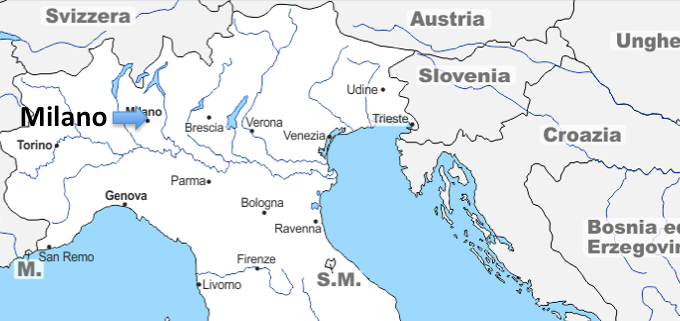
A European Journey #29 – Milan (Italy)
Today we will continue our mini-trip in the footsteps of the Waldensians to discover the legacy of their movement in Europe.
After three stages in France, we will now cross the Alps to Milan. This city, which is the capital of Lombardy was founded in the year 600 BC and is today the second most populous city of Italy.
Milan contains some of the world’s most renowned architectural works of art, such as the Duomo di Milano and the Teatro alla Scala. But for our purposes, we will walk 900 meters east from the Duomo, cross the main boulevard Via Larga to the Waldensian church called San Giovanni in Conca.
The church is located opposite the gardens of the Palazzo Sormani, a seventeenth century baroque building, which is now the main library of the city. The church has a Romanesque Revival façade and quite interestingly it actually comes from another church, which was demolished for the building of a road.
Unfortunately, we only have fragments of the story of the Waldensians in Milan at the beginning of the thirteenth century. Nevertheless, some elements can help us to have an idea of what happened here in those times.
the Waldensians maybe arrived in Milan around the end of the twelfth century only a few decades after the city had been destroyed by the German Emperor Frederick Barbarossa. They probably settled there with Waldo himself following their expulsion from Lyon.
In those days, the politics of the city were dominated by the Pataria movement, which aimed to cleanse the church from political corruption, especially from the practice of selling church offices, a practice called ‘simony’.
This movement turned Milan into a place of refuge for dissident groups, just as was the case in City-States like Metz and Strasbourg, as we saw during the last two weeks. Some sources relate that there might have been up to seventeen different groups of this kind in the city. Some were more religious than others.
Thus when the Waldensians arrived in Milan, they met groups that were quite similar to them. One such group was the Umiliati (Humiliates), who also vowed to live a life of poverty. They were followers of Arnaldo of Brescia. This man was one of the earliest reformers and he was eventually martyred in Rome. Their name, Umiliati, comes from the fact that they practiced poverty and dressed simply. They denounced the clergy, however, more vehemently than the Waldensians. They were also committed not to lie or to swear.
It was because of their stance in favour of lay preaching that the Umiliati, like the Waldensians, were declared heretics by Rome at the Council of Verone. The Pope knew very well that this practice was one of the keys that could put an end to Catholic power over Europe.
Understandably, as they lived in the same city and shared many of their views, the Umiliati and Waldensians became known together as the Poor of Lombardy. But in practice, they never really became united, as they diverged on several points. These were not simply theological details but points that influenced their way of life. For example, the Waldensians understood that solidarity was to be practiced through working for one another. The Umiliati instead believed that solidarity was reached through begging, a principle that was also central to another rising movement of the time, the Franciscans.
The Waldensian view of work can be seen as an early development of Protestant work ethics. This, in turn, was at the root of the economic success of Protestant Europe.
Another central aspect of the Waldensian movement was education. Early texts mention that the Waldensians acquired a land in Milan on which they built a schola. We are not sure what that schola might have been or where it was located. But from what we know about the Waldensians, it would not be surprising to discover that the schola was simply a school where people could learn to read the Scriptures. Sadly, it was quickly demolished under the order of Filippo I of Lampugnano, the Archbishop of Milan at the beginning of the thirteenth century.
The weak position of the Catholic Church in Milan at the time did not permit them to launch a crusade against the Waldensians as had been done in other parts of Europe. So, instead, Rome tried to infiltrate the movement, through the work of . Durand of Huesca, in particular. He was a former Waldensian who had returned to the Catholic Church. He founded the movement of the Poor Catholics in order to win the Waldensians back to Catholicism. But his work never bore much fruit.
The Waldensians in Milan faced persecutions in later times. But the simple fact that we find a Waldensian church here in Milan is proof that the movement has not died.
See you next week somewhere else in Europe.
Cédric Placentino
Schuman Centre convener for Italian and French Europe
Follow A European Journey here.

This Post Has 0 Comments